#perverse homage
Text

𝕰𝖓𝖙𝖗𝖆𝖓𝖈𝖊𝖒𝖊𝖓𝖙
14 notes
·
View notes
Note
On which Body part would Terry most likely get a tattoo of his Beloved's name?

---
Anywhere that's indicative and symbolic?
The letters of beloved's name tattooed in a circular, coiled shape around his finger to discreetly and elegantly mark the fact beloved's quite literally wrapped around it? Or perhaps somewhere in or around the Cobra fist tattoo he used to have on his ribs to showcase two of the most important loves he has being united in ways; Cobra Kai's Karate and beloved themselves? Perhaps, in his older age, once the Cobra tattoo is long since removed, beloved's name, or at least a faded initial of it is the only thing he leaves behind on the red, marred flesh as a keepsake.
Beloved's still there even when he deliberately laser erased everything else.
Maybe, under different circumstances, he'd place the letters of beloved's name on each of the knuckles of his fists, so when he fights, trains and draws blood from an enemy, they're right there, in every punch, stroke and every delivered blow. The idea very much tickles him. He'd privately enjoy the thought of dedicating violence and carnage as an homage to the one he loves and he would've done it too if the conventions of the corporate, upper crust world and the wider World at large wouldn't be such where something so intimate to him would be a little too on display for his tastes.
Somewhere on his bicep?
John tattooed his Cobra on his bicep back in the days and the bushy-tailed, wide eyed young soldier in Terry would always harken back to drawing inspiration from things his Captain and friend did, regardless if they're currently on good terms or not and regardless if he wants to or not (which could be a source of unforetold personal baggage and angst, something being beyond his control), so of course the idea of tattooing beloved's name on his bicep immediately comes to mind; the placement a kid getting their first ink would choose, perhaps, almost like Terry never grew out of certain things regardless of his age when he ponders this decision.
How about on his leg? His arm? On his back?
On the sole of his foot heel when he's angry, betrayed or somehow agitated, feeling beloved has too much control over his mind, body and soul as is. He isn't the robot. He makes other people his robots. That the very fact he wants to brand himself with them is reason enough for him to set things straight and ink their name on his heel so he can always step on them for the rest of his life, as elaborate revenge and a constant reminder to himself who belongs fucking where in the grand pecking order.
How about somewhere perverse, eccentric and risqué for his own (sadistic) amusement?
I think Terry Silver ultimately settles on something wildly conventional (considering how extravagant he can otherwise be) and something almost classically romantic (and even cliched) such as tattooing beloved's name in small letters above his heart or going as far as personally peeling away tiny, strategic layers of flesh and scarifying beloved's name into his skin himself, dedicating every bit of pain, zeal and discipline it took to achieve this end goal to them and his own capacity to endure the process with relish as a testament to his own strength.
#terry silver#kk3#cobra kai#tattooing#inking#tattoo#terry silver x reader#terry silver x beloved#tw; scarafication#tw; self mutilation
16 notes
·
View notes
Text
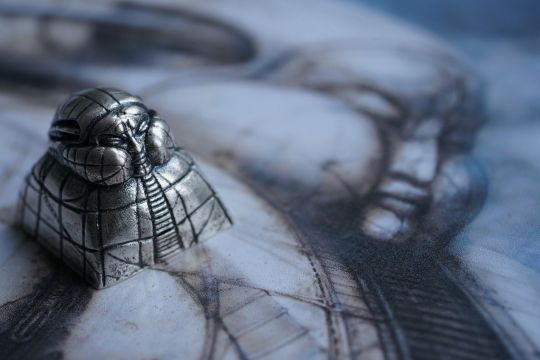
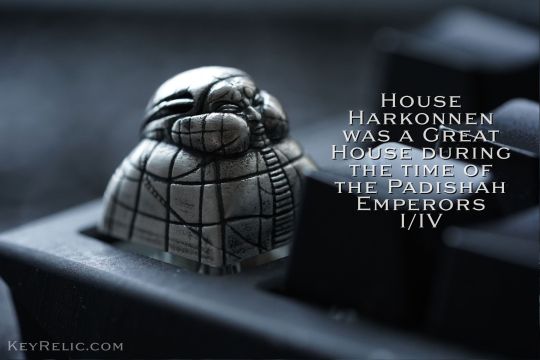



Baron Vladimir Harkonnen Fortress - Inspired by H.R. Giger concepts for Jodorowsky's DUNE Metal Artisan Keycap for Mechanical Keyboard
A homage to H.R.Giger's art concept for Jodorowsky adaptation of Frank Herbert's 'DUNE'. 🎨
This movie never came to happen. However, their work became an inspiration for generations of artists. 🎬🖌️
We are one of them. 🌟
💰 https://keyrelic.etsy.com
H.R. Giger said:
'My planet was ruled by evil, a place where black magic was practised, aggressions were let loose, and intemperance and perversion were the order of the day.
Just the place for me, in fact. The castle itself, a symbol of intemperance, exploitation, aggression and brutality with a magical aura which has a negative effect on all the inhabitants, is egg-shaped and mostly buried in the ground.
Like an iceberg which shows only a tenth of its volume, Harkonnen hides its evil deep inside.
The main gate is only an entrance, never an exit, for it has barbs like sharks' teeth which prevent anyone from turning back.'
#keycap#keyrelic#metal#mechanical keyboard#dune#alejandro jodorowsky#harkonnen#vladimirharkonnen#geek#premium keycap#frank herbert#dune movie#h.r. giger#biomechanical#characterdesign#dune 2000#dune 2024#dune 2#dune ii#dunemovie#70's movies#jodorowsky's dune
13 notes
·
View notes
Photo


On Tuesday night (18 April) a gang of us assembled to watch the film Saint-Narcisse (2020) by Canada’s perverse and provocative queercore (or should that be homocore?) renaissance man Bruce LaBruce. (The Guardian reviewer summarizes it as “a sluttily sacrilegious story of incest, witches and wayward monks” – so something for everyone!). The event was billed as “An Evening with Bruce LaBruce” and LaBruce himself (wearing an ultra-desirable Kenneth Anger / Lucifer Rising bomber jacket) was in attendance. He called Saint-Narcisse his homage to 1970s Quebecois cinema, which explains the gorgeous retro tones of orange, brown and gold. I also spotted echoes of Derek Jarman, Pasolini, Marianne Faithfull in Girl on a Motorcycle – and The Patty Duke Show! Pictured: Pal, myself and Fenella. (Bruce LaBruce used to be active on Tumblr. I suspect he left in disgust after @staff‘s homophobic “Adult Content” purge of December 2018!).
#Bruce LaBruce#saint-narcisse#queercore#homocore#underground queer cinema#london#shoreditch#east london#lgbtq#rich mix#queer
19 notes
·
View notes
Text
admittedly i watched Zoran play engage and then was like "i never want to ever touch this with my own hands, this game fucking sucks and i hate it" so maybe i missed some extra dialogue but like. in awakening s supports have a specific mechanical purpose: they lock off a pair of characters from any other s supports and, if there's a child attached to one or both of the characters, they unlock that child's paralogue after chapter 13. the exclusivity makes sense because the point is to give you access to the child units, as a homage to the second generation in genealogy, because awakening was looking back at every fe game that came before it, and also as a way to build on Lucina's purpose in the story as someone who is willing to do absolutely anything to break the cycle they have found themself stuck in. i think s supports in awakening MAKE SENSE because the game is about 1) building relationships with other people 2) inevitable cycles of behaviour and 3) having children*. it's about parenting and s supports in awakening have significant and meaningful contributions to the games mechanics and themes. all in harmony. and they get different dialogue with each other once they're s supported and if they're paired up they're blushing in their portraits on the lower screen it's cute. there was a degree of thought and care
s supports in FATES exist because fates was all but directly called "this is the sequel to awakening". as someone who loves awakening i think all the worst bits of fates either directly copy or are a response to something in awakening. fates has s supports because awakening had s supports and the expansion of the mechanic to TWO corrin-only same sex s supports demonstrates that it was no longer mechanically and thematically grounded but instead trying to imagine a product that the maximum possible number of people would buy. would people be disgusted if some or god forbid all of the characters they are meant to desire had homosexual inclinations? surely they would. therefore the fujos and the tharja fans can have a bone thrown into the dirt while the entire rest of the game can reconfirm to itself and its audience that homosexuality is disgusting and perverse and that any deviation from the norm will be punished. job done!
I'm not even sure if SoV has supports given that those first started appearing in genealogy / fe7 and that it was remade closely enough to keep all the misogyny in but with no player avatar there is no need for s supports confirming that the player of this game is the most important incredible specialest person in the whole wide world
the fact that three houses has s supports at all makes me so fucking mad. it shouldn't. yet another reason why 3hopes reigns supreme. in short without the ability to s support characters other than the player avatar the mechanic has been reduced to fairly naked pandering and an invitation for the most graceless and desperate projection. add to this the disparity between m/m and f/f content not just for byleth but in paired endings more generally and it is apparent that characters who exist in the story independently of being sexually available for the player was not the priority. barf
and then engage takes the momentum from three houses "prioritise the potential feelings of the player above all else" approach and adds the least interesting and dynamic same sex options i have ever seen alongside and with the exact same prominence as putting a ring on the finger of alear's little sister. BARF!! are you really satisfied with this??
#hater moment#*please note that “having children” and “parenting” are specific experiences and specific themes#and “family” . is not. “family” as a theme is nothing. happy families? broken families? the existence of the idea of family??#why settle for that. why pretend that's satisfying. demand better
2 notes
·
View notes
Photo


May 18th 1313 saw Robert the Bruce invade the Isle of Man.
The Isle of man has changed hands many times through the centuries, if you go back to Scotland before King Alexander III died, plunging the country into the Wars of Independence, he had extended his Kingdom to include Man and Berwick, both of which are part of England nowadays.
Scotland’s rule was not welcomed in 1275 an uprising in Man against Scottish rule was brutally suppressed. The chronicles tell us that…..
“ Upon the 7th of October, the Fleet of the King of Scotland put into the port of Ronaldsway. John de Vesci and the King’s nobles immediately landed their forces on the island of St. Michael, the people of Man being prepared for the encounter, along with Godred, the son of Magnus, whom they had made their king but a short time previously. The chiefs and officers of the King of Scotland, however, sent an embassy of peace to Godred and the people of Man, offering them the peace of God and of the King of Scotland on condition of their laying aside their absurd presumption, and of giving themselves up to the King and his nobles. As Godred, however, and some of his perverse counsellors did not agree to the terms of the embassy, on the following day, before sunrise, whilst darkness still covered the earth, … an engagement took place, and the unfortunate people of Man, running away, fell miserably “
If you notice the names of Godred and Magnus, the island was still very influenced by the Scandinavians. Their influence was again noted in 1291 when
” the Noble Lady Maria, Queen of Man" a member of the Scandinavian royal family of Man, did homage to Longshanks at Perth. Two years later in early 1293, Walter de Huntercombe, who held Man for a short time, surrendered the island to John Balliol by Edward’s order, of course Edward had the proviso that Balliol swore him allegiance. The next year Balliol refused to send Scottish soldiers to fight with Edward against the French, the Scottish King entered into the Auld Alliance and also formed a little known Alliance with Norway. Furious Edward marched his army into Scotland and the Wars of Independence raged for several years, during this time little is written about Man, it seems he garrisoned soldiers there and it feel under English rule. Edward I and his son Edward II “gave” the Island to differing lords to administrate until 1313, the chronicles tell us that
“In the year 1313, on the 18th of May, Lord Robert [Bruce], King of Scotland, put in at Ramsay with a large number of ships, and on the following Sunday went to the nunnery at Douglas, where he spent the night, and on Monday laid siege to the Castle of Rushen, which was defended by the Ilord Dungali Mac Dowyle 41 against the said Lord King until the Tuesday after the Feast of St. Barnabas the Apostle (June 21), on which day the said Lord King took the Castle.”
On the 20th of December, in the same year, Bruce granted the island to Thomas Randolf, Earl of Moray, “
The defeat of the English at Bannockburn consolidated the Scottish position. It’s a bit vague about what happened but the English seemed to have taken control, under Edward I by 1317, and he had committed the island to the safe keeping of John de Athy and orders him to provide three ships and
” a sufficient armament of warlike men “ to protect ” it against the hostile attacks of our enemies and rebels the Scots.“
But it is a bit confusing as , three months later, Randolf, Earl of Moray, is spoken of as ” being about to set out for the parts of Man,“
Some sort of truce prevailed for some time on the run up to 1328, when the independence of Scotland was formally acknowledged and the King of England gave an undertaking not tc assist any enemies of the Scots to dispossess their of Man,” it is probable that Man had before that date reverted to Scotland.
Roll on to 1333 and the English were at it again, with the help of the “disinherited” they helped John Balliol’s son Edward invade Scotland, which brought us to today’s date that year when Edward III gave orders that possession should be taken of Man. He granted the custody of the island to Sir William de Montacute, and, further, on the 9th of August, he gave it to him as his absolute possession-in the words of the grant - he
“ remitted, surrendered, and … assigned peaceful possession of all the rights and claims which we have, have had, or in any way could have in the Isle of Man, … so that neither we, nor our heirs, nor any other in our name shall be able to exact or dispose of any right or claim in the aforesaid Island,” thus not reserving any service to be rendered to himself.“
The Scots again threatened to retake Man in 1337 but it was unsuccessful, the Isle of Man has since been seen as part of England.
56 notes
·
View notes
Text
A review of Querelle de Roberval by Kevin Lambert
I picked up Querelle de Roberval at work and decided to read it with absolutely zero expectations or knowledge of its contents, only a deep love for Genet’s work. It is, it seems, meant to be an homage or at least inspired by Genet’s novel Querelle de Brest. I spent the time it took me to read the book completely uncertain whether I liked it or not, and after having finished the novel and mulled it over for the rest of the day, I think I have to conclude that I didn’t like it.
It is well written; Lambert’s prose is stylish, sharp, and flows well. I am not Canadian and therefore don’t know the nuances of specifically Quebecois politics or social issues, but I really struggled to pin down the political message of this book, and it was clearly gunning for something. The ironic, fourth-wall breaking chapter at the latter half of the book set the stakes for the rest of the book too high; the scene in which the neighborhood Greek chorus mourns over Querelle’s body does not feel as heightened as it was obviously meant to feel, because the fourth wall chapter cuts down any faith the reader may have in its glory or passion.
Stylistically it felt like two separate novels that someone had attempted to twist together into one -- the realism of the strike, and the poetic fantasy of Querelle’s world and that of the other queer boys. Unfortunately, either the attempt at combining them was not strong enough, or the lyrical alienation of the queer world from the straight working class world was not deliberate enough.
Aside from the two main characters, Querelle and Jezabel, the rest of the cast felt undercooked; some were not fleshed out thoroughly enough, and some should have remained more like two-dimensional side characters but were given only a little bit extra characterization and therefore felt strange and incomplete.
And unfortunately I couldn’t help but compare Lambert’s work to Genet’s original, and it falls far short of the beauty of Querelle de Brest, or Genet’s work in general.
Part of the fascination of Genet’s work is how often violence or “perversion” (sexual or otherwise) is not an act of revenge or anger, but one of love or reverence, and more importantly one of transcendence. Aside from the descriptions of Querelle with his lovers and Jezabel’s final act in the pool, this symbolism and emotional transformation did not occur. The violence was just violence, something more akin to torture porn than something loving, transcendent, or symbolic. Murder itself - the actual taking of a life - as an extension of the self and therefore an act of complete liberation of the self is not the point of Lambert’s work like it is in Genet’s. Instead, it is the violence itself, the causing of pain that he seems to focus on. In Genet’s work (particularly Funeral Rites), consumption of another is not an act of revenge or hatred as it is in this work, but one of reverence and love. Acts of violence such as sacrifice, murder, and betrayal take on a transcendent, romantic symbolism because they are acts in which the self is destroyed and transformed into something else. Corruption, violation, violence, perversion, are rarely about the outside world directly. Rather, they are ways in which the self becomes something more, confirms itself to be a living thing or an empty thing or a thing which acts out of love, submission, or dominance. Rarely are acts of violence things Genet’s characters do solely for themselves; they are ways in which two characters are eternally entwined, which is what makes his violent or twisted characters so romantic.
All this is something that is consistent throughout Genet’s work and blatant in both his direct prose and his symbolism. Much of the violence in Lambert’s work lacks that philosophical thoughtfulness, and the political passion that would have smoothed that over does not seem fully thought out.
Unlike Genet, whose feelings towards authority have a conscious duality and whose works are unmistakably working-class, with the questionable morals of its characters being portrayed as a positive aspect, Lambert seems more intent on portraying the strikers as reprehensible in their actions, in that they are merely violent rather than transcendent in some way. This frames their actions then as either simply brutish or ultimately futile, rather than an act or event which either allows them to come alive for the first time or to change their self into something else. It also means that the characters whose morals are more “old-fashioned” like Fauteux or Bernard do not have the same dark, rounded-out intent and shadowy depths like that of Mario in Querelle de Brest, and instead are simply shallow and unlikable due to sexism etc.
In Genet’s works, violence always, always means something symbolically, and its meaning is usually expanded upon through descriptions of the character’s internal monologue or reaction or transformation. But much of the violence in this book was simply vengeful or retaliatory (the coffee, the molotov cocktails) and the moments during and after the fight with the baseball bats did not dig deep enough into any symbolism to make it feel like anything more than a violent, vengeful midnight rumble at a park. The closest thing was perhaps Jezabel’s vision in the grass of the little children healing her wounds and the neighborhood sleepwalkers singing a Greek chorus mourning for Querelle, but even that did not quite dig deep enough into the the tender, sensitive bits of Jezabel’s emotional transformation.
Querelle, in this case, was not a vehicle by which the novel’s characters as well as the reader are made to ponder relationships between people who mirror each other or expose hitherto unknown passions or weaknesses; instead, he was simply a vehicle for violence that is hardly thought out, and the brief paragraph referencing the sexual insecurities and incestuous perversions of the fathers was not enough to change that. Similarly, the sex scenes in the novel could have been the most Genet-esque thing about Lambert's text, but it supplants the transcendent and self-defining or self-immolating nature of strange or unsavoury sex in Genet's works with simple brutality. The "second" boy of the three unnamed teenagers nearly meets the brief, as he is described as having love within him that the other two must dig out, but Lambert only allows this theme a single sentence, then returns to grotesque and visceral sex without the layers of symbolism and subconscious conflict that gives Genet's views on sex that mystical, philosophical quality.
Within Genet’s work, his voice not as the narrator but as the literal writer Jean Genet is consistently inserted, so that throughout all of his novels he inserts himself and his own thoughts and experiences into the narrative, breaking the fourth wall to describe a memory or emotion of his past that connects through layers of symbolism and feeling to the narrative. The single chapter in which Lambert breaks the fourth wall and lets his voice through does no such thing, and is introduced so late in the novel that it simply pulls the reader out of the narrative entirely, and it is a struggle to get back into it.
No matter how meandering or erratic the narrative of Genet’s work, it always seems extremely self-contained, as though Genet has tight control over every piece of the story and his choices to digress to a personal memory or focus on a different character are deliberate. The self-contained nature of Genet gives the reader the sense that he is writing for himself first, and for an audience second. Lambert’s work, while interesting, can’t decide if it wants to be a kitchen sink drama or magical realist, and therefore its rambling nature seems less self-contained and less controlled.
I think the major issues I had with this book were its ambiguous political stance, its uncooked characters, and its rather bland use of violence. Compared to Genet’s deeply personal, extremely strong and passionate symbolism and emphasis on emotional and mental transformation, this novel felt shallow and disconnected, and without any firmly established positions, opinions, or symbols. I think if an author writes a novel and deliberately mimics the title and main character of a different, more famous novel, they should have a clear and solid reason why they have chosen to draw such a distinct and direct line, and some consciousness of how their work will be compared to the other by readers. This book seemed to lack that clear reason or that consciousness.
3 notes
·
View notes
Audio
𝕷𝖆𝖒𝖕𝖎𝖗 – 𝔚𝔥𝔢𝔯𝔢 𝔗𝔥𝔢𝔯𝔢'𝔰 𝔑𝔬𝔱𝔥𝔦𝔫𝔤 𝔏𝔢𝔣𝔱
Demo IV / Perverse Homage / 2022
32 notes
·
View notes
Text
Carrie (1976) by Michael Bump
Carrie (1976) by Michael Bump
Carrie is a 1976 film directed by Brain De Palma. The film is based on the novel of the same name by Stephen King. The story is about a high school student named Carrie White who has telekinetic powers. Carrie is bullied by her classmates relentlessly. As her powers grow stronger, she began to become isolated, and her powers were unstable leading a tragedy at the high school. The opening of Carrie starts with her experiencing her first period in the locker room. Carrie was unaware of what was going on with her body. Carrie became visibly upset and her classmates began to tease her. Word of the incident quickly spread through the school and Carrie began to get bullied much worse. Sissy Spacek does an amazing job portraying the character's vulnerability and innocence. An interesting aspect of the film is the use of split screen scenes. In doing so the viewer is exposed to multiple scenes at once. The music playing throughout the film is haunting and atmospheric. It provides the movie with a consistent feeling of doom and unease. Carrie’s mother is played by Piper Laurie. Margaret White, Carrie’s mother, was a religious fanatic. She behaved abusively towards her daughter. Laurie’s performance is chilling.
The climax of Carrie, and most likely one of the most famous scenes from the film, is when Carrie is drenched in pigs' blood in front of her classmates and by her classmates. The picture I tagged along with this post is a photo from that scene. Films and television pay homage to this scene by recreating it in their own projects. The music during this scene is ominous. The scene felt like it lasted a long time, and the combination of effects and terrifying music made that scene epic. The film’s ending and the book’s ending differed from each other. The end of the film is tragic for Carrie unfortunately, she ended up succumbing to the abusive parenting of her mother.
Carrie is a classic horror film, but the message still holds true today. The message of what happens when someone is bullied and pushed into isolation. This is a testament to what would happen if the one being bullied had telekinesis and could take revenge on their abusers. The year that Carrie was released had many historical events. The first event was Jimmy Carter defeated President Gerald Ford, who was the incumbent, and became the country’s next President. It was a shocking upset because it is common for the incumbent President to get reelected. The other major historical event in 1976 was the landing of the first Martian module. It was the first craft ever to reach the surface of Mars.
Carrie is the epitome of horror. It was well received by the audience. The budget for Carrie was a little over One million dollars. After the release, the film grossed over thirty-three million dollars worldwide. Carrie is a conventional Hollywood horror film. Although there are elements of terror that are unlike other films in the same genre. The music of the film tends to stick in the ears because of how disturbing it is. Anyone who is interested in scary movies should see Carrie. It is a classic Stephen King novel brought to life.
“Part of his success is a result of the very good performances by Sissy Spacek, as Carrie, and by Piper Laurie, as Carrie's mother. They form a closed-off, claustrophobic household, the mother has translated her own psychotic fear of sexuality into a twisted personal religion. She punishes the girl constantly, locks her in closets with statues of a horribly bleeding Christ, and refuses to let her develop normal friendships.” Roger Ebert
“Carrie” is a terrifyingly lyrical thriller. The director, Brian De Palma, has mastered a teasing style—a perverse mixture of comedy and horror and tension, like that of Hitchcock or Polanski, but with a lulling sensuousness. He builds our apprehensions languorously, softening us for the kill. You know you’re being manipulated, but he works in such a literal way and with so much candor that you have the pleasure of observing how he affects your susceptibilities even while you’re going into shock. Scary-and-funny must be the greatest combination for popular entertainment; anything-and-funny is, of course, great—even funny-and-funny. But we come out of a movie like “Carrie,” as we did out of “Jaws,” laughing at our own childishness. It’s like watching our team win a ballgame—we’re almost embarrassed at how bracing it is.”- Paula Kael 1976

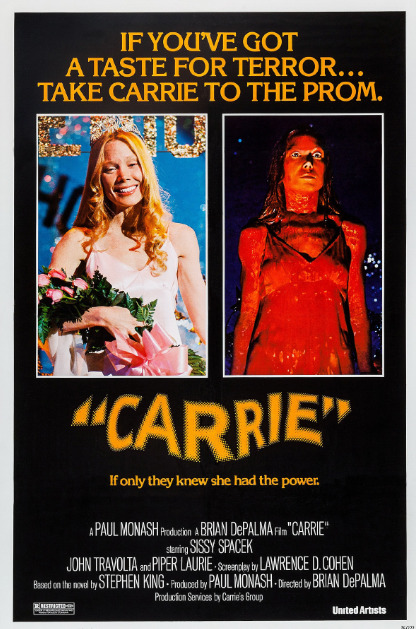


Carrie (1976) Prom scene
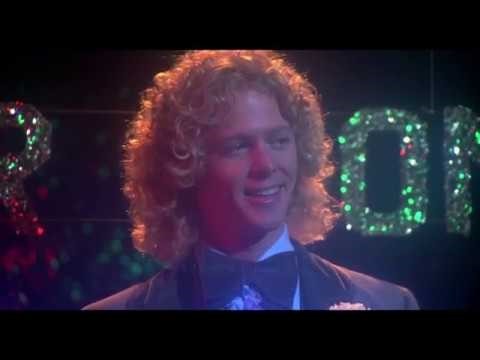
3 notes
·
View notes
Text
The Price May Be Right - Number 30
Welcome to “The Price May Be Right!” I’m counting down My Top 31 Favorite Vincent Price Performances & Appearances! The countdown will cover movies, TV productions, and many more forms of media.
Today we focus on Number 30: The Sinister Man, from Bloodbath at the House of Death.
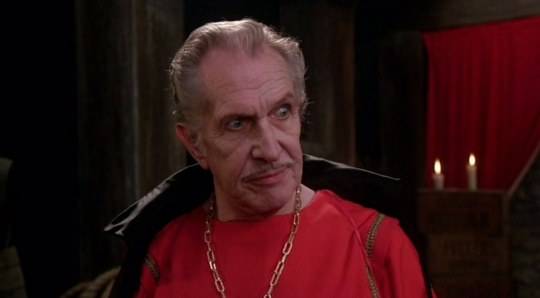
This…is not a very good movie. XD “Bloodbath at the House of Death” is a 1984 film that essentially attempted to do a non-musical version of what things like “Rocky Horror Picture Show” tried out. The film is a satirical, farcical comedy with a surreal and perverse sense of humor, which takes various horror and sci-fi tropes, then mixes and mangles them all with a combination of slapstick, over-the-top camp antics, and a heavy dose of vulgarity. However, while “Rocky Horror,” in my opinion, is successful in its attempts to both mock and pay homage to the genre and its cliches, “Bloodbath” is much less competent. To be blunt, it’s just not very funny.
However, the movie is not completely without its merits…and most of those merits come from Vincent Price as the main villain of the story: a mysterious figure known simply as The Sinister Man. This wicked and wily antagonist is the leader of a Satanic cult. Years ago before the start of the film, this cult committed a massacre in the titular House of Death, and they now guard the property in secret, using it as a headquarters for their bizarre rituals. When a team of scientists go to the aged manor, investigating strange radiation readings emanating from the property, the Sinister Man bands his forces together to purge the outsiders from their lair.
This is one of many times in Vincent’s career – particularly common in his later years – where he essentially is performing a work of self-parody. In fact, this was a fairly common thing with a lot of horror actors from years past, including Vincent’s friends, Christopher Lee and Peter Cushing, not to mention even older performers, such as Boris Karloff and Bela Lugosi. However, I would argue the difference between some other performers and Vincent’s way of working was that, even during his prime, Vincent ALWAYS had a sense of humor about himself and the reputation he had. As time went on, as a result, he was more than happy to joke about in such projects; it always felt so honest with Price. As if he was laughing right alongside the audience, happily guiding them through the mayhem.
It’s this sparky sort of humor that makes Price’s turn as the Sinister Man genuinely great to watch. He makes the worst jokes suddenly snicker-worthy, and the few jokes that were already good suddenly become HILARIOUS in his skillful hands. He plays the Sinister Man with a sort of foppish silliness, as if he’s actively TRYING to be this all-powerful figure of grand oratory and awe, but his pomposity is constantly punctured, causing him to revert to a spoiled brat. It’s like if Daffy Duck decided to play…well…Vincent Price! And that’s a lot of fun to watch. A lot of my favorite comedic moments in Vincent’s career actually come from this one movie; therefore, even though the picture as a whole isn’t very good, I still felt it was worth giving it attention on the countdown.
Tomorrow, the countdown continues with my pick for Number 29!
#list#countdown#best#favorites#top 31 vincent price performances#the price may be right#number 30#vincent price#movies#film#horror#comedy#actors#acting#bloodbath at the house of death#sinister man
4 notes
·
View notes
Note
Would Terry ever share what goes on at Dynatox with beloved? Do you think he would ever talk about his day?
Yes.
Deep down, I feel that Terry Silver is someone who always yearned to be accepted and loved in spite of all the bad, horrible, awful things he's done and continuously kept doing more or less throughout his entire life and I figure that is literally why he has never found someone he could have anything more than a passing adventure with. Because that's a huge standard to set. To accept the pitch blackness of Terry's past without him having to leave out something or hide certain aspects of it? It is big. Yet, with him, there's always this want to show the worst, darkest sides to himself alongside the worst, darkest impulses and be cared for in spite of it all., and it verges borderline into the perverse and morbid where he'd almost deliberately itch to gleefully and smugly shock someone and test them alongside their resolve and devotion to him, in effect, by intentionally telling them about things he's seen in Vietnam, done in Vietnam, things Dynatox does, crimes he's covered up, attorneys he's bribed, laws he's broken, lies he's told and gotten away with, people he's hurt and enjoyed hurting, all the corruption, bigotry, coke and malice. The whole package, baby! If he's to be loved, he's to be loved for all of himself or not at all. Man invited Johnny Lawrence to the abandoned dojo to beat him to a pulp as a proof to an onlooking Kreese that he's loyal to Cobra Kai, after all. To Terry, that was a showing of raw devotion. When Kreese didn't approve of Terry's homage to him, he had him framed, because Terry saw that as John not loving him in spite of the bad, horrible and awful.
And of course a snake wants to be a snake.
He's a snake. That's in his nature.
Can a snake be loved and still retain its serpentine nature? Is a cobra evil?
Does it have neuter itself?
Is that still love then?
Or is it defeat? Living in captivity? In a zoo? A cage?
Is a genuine relationship, a true friendship, or any lasting, honest bond even possible if one doesn't know about all these grimy parts of someone's soul? I have this feeling Terry doesn't think so. I think the exact reason why Terry at the start of Season 4 seemed so repressed and weirdly out of touch with his surroundings, outside of his own mental instability, is precisely because he's done bad things and he's seen some even worse things and he couldn't tell anyone about it, wearing this elaborate, watered down facade in cage of his own making, because in telling people about it, he knew that the artificial collective of token friends he acquired would revile him and probably with good reason, because Terry never was the best of people, and even if he doesn't see himself as a bad man (What bad man does? Terry is the hero of his own story too, in his own world), he understand the stigma that comes with certain actions. Like polluting developing countries by dumping toxic waste for profit. But, if he loved someone and expected them to love him back, yes, he'd tell them what Dynatox does. In arduous detail. Why? Because Terry wants to see how far he can go and how far the extent of someone's love for him goes, being used to forming attachments under extreme moments of duress and under some very extreme circumstances; something he brought home from the war and his friendship with John and Ponytail and I don't think Terry has a frame of reference to form attachments of a genuine kind in a commonplace way, due to his own trauma.
Is it unconditional then, this love you have?
How about if he's responsible for a wildfire in the Amazonian rainforest?
Still unconditional?
What if Dynatox was behind the displacement of the native tribes in Borneo?
How about then?
Okay, so how about if he's behind an oil spill the size of France in the Pacific Ocean?
Do you still love him?
Would you love him if he paid off corrupt governments to get away with it too?
What if, at one time, he was a scared boy, deep in the jungle, and he was loved enough at his smallest and weakest for someone to stand up and offer to fight for him? If someone could do that, with nothing to gain but a good friend's life, why can't you love him when he does bad things? If you don't, it means you simply aren't on his side enough, he feels.
You're ether with him, or against him; he deals in absolutes like that.
Capitalism is a tool, and if he could know, for a fact, that someone's love for him would persist even if he was the match that singlehandedly burned down the world, then he would gladly utilize it to find out. Ironically, once he's well assured, he might as well turn Dynatox towards green energy purely for his beloved's sake, because everything's his oyster. Extremes, right?
#terry silver#kk3#cobra kai#dynatox#tw; pollution#tw; enviromental disasters#tw; capitalism#tw; natural catastrophe#terry silver x reader#terry silver x beloved#character analysis
33 notes
·
View notes
Text
M’Grasker Debuts Bold New Single

M’Grasker is a coven of humanoid meat sacks forged in the Vats of Creation by Dr. Gorp. Their mission: to Rock. However, they are also permitted to Roll. Human terminology might define them as a “band,” however they would be more accurately described as Biological Property of M’Graskorp Unlimited Enterprises and Subsidiaries of the GlanGlan Group. M’Graskorp’s renowned legal team compelled Jesse Turnbull (Taurus Music) and Dave Monks (of Tokyo Police Club) to engineer and produce their forthcoming self-titled album, due this year.
They present a psychedelic symphony in the form of “Kiss & Smoke Weed,” an amorous and trippy song that pays homage to the twin pillars of human joy: a kiss, the sweet interlocking of souls, and the goij, the herb that unravels the mind's knotty woes. Imagine the harmonic convergence of lips meeting 'twixt loving gazes and the effervescent dance of goij smoke waltzing through the air. Its intoxicating groove offers a kaleidoscope of sounds, accompanied by a phantasmagoria of color and love.
youtube
Much of M’Grasker’s DNA was salvaged from the backstage areas and bathrooms of seedy Toronto music venues and transferred via Scienetic Quantum Hurtlage to the M’Graskorp Labs, located just beyond Space and Time (and slightly to the left). There, the illustrious Dr. Gorp folded the DNA into his patented bio-muck through perverse osmosis, adding a large scoop of adrenaline and dashes of other substances that can’t be named, much less comprehended.
After releasing their ‘curt’ 69-track EP Under the Righteous Sky in 2022, the band endured a brief transmogrification when canine DNA entered the Vats, resulting in the dog-themed follow-up Must Love Doggy in 2023.
0 notes
Text
Augustus Muller Interview: Synth Stories

Photo by Jimmy Fontaine
BY JORDAN MAINZER
For Augustus Muller of Massachusetts-via-Georgia electropop duo Boy Harsher, feeling the pressure gets results. Not for the duo's studio albums, mind you, but for the impressive number of film scores that he and Boy Harsher have been releasing the past few years. "Soundtracks are cool because you have 2-3 weeks to write them. You have to be prolific in that amount of time," he told me over the phone last month. "A record is going to take a couple years to finish, for the same amount of music...you don't have a lot of time to make a mistake." Looking at Muller's history as a creative, from his early days to his recently released scores for Cellulosed Bodies and My Animal, his spontaneous mindset has paid off.
Before he made music, Muller was an aspiring filmmaker, creating short films as a teenager, and attending film school. As he started making music for his own films, he realized her liked that part, too, and his career shifted. Of course, his project with film school classmate, vocalist Jae Matthews, took off, starting as Teen Dreamz and eventually becoming Boy Harsher, as the combination of her spoken word and his beats became more dance-oriented. Films were on the backburner, and it wasn't until 2020, when he teamed up with progressive adult film producer collective Four Chambers, headed by experimental pornographer Vex Ashley, that Muller released his score debut. Machine Learning Experiments (Original Score), comprised of distinct scores to two films (Orgone Theory, tracks 1-5, and Hydra, tracks 6-10), was released via the band's imprint Nude Club Records. In combination with the film's subject matter and Boy Harsher's usual minimal synth wave, the music fittingly sounded like a sort of dystopian cousin to the works the late Patrick Cowley made for John Coletti in the 80's. And early last year, the band released The Runner, which started as a piece of music but sounded to them so suited for the screen that they simply directed an accompanying short horror film.
Now, Muller has given us two more scores. Cellulosed Bodies is another collaboration with Ashley, structured similarly to Machine Learning Experiments in that it features two scores for two films, Crash and Automaton. What makes Cellulosed Bodies a standout in Muller's oeuvre is that the two scores that make it up simultaneously provide a cohesive whole and exercises in textural contrast. Both films deal with the relationships between bodies and machines, the former an homage to David Cronenberg's erotic body horror film of the same name, the latter exploring pandemic-influenced digital isolation and dependency. Crash uses all analog instrumentation, sounding appropriately tactile on the pulsating synthesizers of "Fur And Metal" the crispy, synaptic drum machines of "Perverse Technology", and the booming bass of "Shattered Glass". Automaton, on the other hand, doesn't abide by as many patterns, using more FM synths for its droning vignettes and metallic harmonics, notably oblique strings and organ synthesis on "Observation" and "Who Is In Control" and vocal samples on "Subdue Yourself". But whether taking a more traditional or contemporary approach, Muller exudes the same visceral quality from his compositions.
On Friday, Muller released his score for Jacqueline Castel's My Animal, which, like Crash, uses mostly hardware but has the same abstractly filmic quality as The Runner. If you didn't know it was a film score, you'd think it was just a standalone piece of instrumental 80s synthwave, as effective in the club as it is soundtracking horror romance. "Sanctuary" borders on stadium rock, layered with drum fills and arpeggios, while the combination of wincing synthesizer and shuffling beats propels tracks like "Transformation #1", "The Slots", "Outside the Rock", and "Something's Building". More simply, many of the record's tracks are heavy on vibes, with the music evoking exactly what the titles suggest: "A Soft Howl", or "Winter Drone". At this point, Muller and Boy Harsher have amassed a solid following for their studio albums, but all signs point to Muller--still an aspiring filmmaker, after all--becoming an in-demand name for helping filmmakers bring their corporeal visions to life.
Below, read my conversation with Muller, edited for length and clarity.

Photo by Jimmy Fontaine
Since I Left You: Describe the process of working on Cellulosed Bodies with Vex Ashley. Was the music made in tandem with the visuals or in response to them?
Augustus Muller: She'd send me a rough cut of what she was working on, and I'd write something to that. It was pretty loose. She cut around stuff. I would send something back, she'd send me notes, and edit around what I'd written. Then she'd send another cut, and we'd work on transitions and put finishing touches on it.
SILY: What's unique about this soundtrack as compared to others you've done?
AM: Compared to writing a feature film, there's a lot more space for music. Crash has no dialogue at all. With porn, the music can lead. I felt like I had full freedom with that. I could write a full track. With other scores, for narrative, you have to hide it under dialogue, so it's a different sound palette.
SILY: Are you often given the whole film without the score, and then you work around it?
AM: Yeah. For Crash and Automaton, there wasn't even temp music. I started from scratch.
SILY: Why did you decide to release "Fur And Metal" and "Stretching / Invading" as the first tastes of Cellulosed Bodies?
AM: For this project, it's been difficult to explain to our fans and the world what it is. It's my solo music, but not an album, but an original score to porn films. People are blasting through social media, not really reading through the fine print. "Fur And Metal" was one of my favorite tracks from Crash, and I thought it was important to share something from Automaton, which is what "Stretching / Invading" is from. It's more of an ambient, droney track. It's good to show the range the album has.
SILY: It emphasizes the distinct textures and qualities of the scores, too. You used strings and organs on the latter.
AM: Yeah. It's two pretty different sounding scores. Similar subject matter--a techno dystopian future--but Crash was all analog gear and vintage hardware. It has that older sound. Automaton is a lot of FM synths to get these new sounds.
SILY: The final track, "Subdue Yourself", has vocal samples [from dominatrix Miss Marilyn]. Why did you choose to introduce voice at the very end?
AM: That track is not in the film. It's something I wrote and ultimately didn't use, but it's a song I really liked. I love Miss Marilyn's monologues, so I thought it was a cool thing to include in the soundtrack. Giving it context, like when original scores and soundtracks have clips from the movie in it.
SILY: Do you think this score holds up separately as its own piece of art? Can it be consumed and appreciated separately from the film?
AM: I think it really varies soundtrack to soundtrack. This one can definitely stand by itself. I'm really proud of the tracks. I think it's listenable. I was just listening to Vangelis' Blade Runner [soundtrack]. I had never actually listened to the LP before even though I've seen the movie a million times. There are a lot of instrumental tracks that must be so low in the mix in the film that when listening to the LP, it felt like I'd never heard them before. They're banging tracks!
SILY: Crash is a direct homage to Cronenberg's film of the same name. Have you ever called out an influence that directly in your music before, whether with Boy Harsher or your solo work?
AM: On tour, we're playing a "Wicked Game" cover. [laughs] But in terms of the Crash score, I watched [Cronenberg's film] and wanted to get Howard Shore's soundtrack channeled through me. I then realized, "I can't do this. Howard Shore's a genius. This is not my style." I just started playing some driving bass and went a totally new direction.
SILY: When I listened to your score for My Animal, I thought it was pretty banging itself. There are a lot of catchy tracks on there, like "Sanctuary" and "The Slots". These could be singles.
AM: I was writing with a lot of temp music. [Jacqueline Castel] was putting Boy Harsher songs in it as temp music. So I was channeling drum-driven material.
SILY: Do you think Boy Harsher songs work well within a film context?
AM: I think so. We've had some stuff licensed for films and TV shows. When I'm writing something, I know it's good when it feels visual, when it's evoking some imagery or takes me some place.
SILY: I feel like certain general aesthetics seem to fit films very well. What are some of your favorite film soundtracks or creative influences when making a soundtrack?
AM: Recently, that Jonathan Glazer movie Birth. Alexandre Desplat does that really tight chamber music. I like it because it's the opposite of what the scene is showing. It really changes the mood. That was really inspiring for me, to show what music can do for a film, to take a scene and transport it into a totally different vibe.
Abraham Marder and Nicolas Becker's [work on Sound of Metal]. I have to shout out Tangerine Dream's Sorcerer. That's such a powerful tool in the film. It really elevates all the emotions, but it's also an album I can listen to on its own.
SILY: Have you ever thought about curating a film's soundtrack, picking songs from other artists?
AM: Like Trent Reznor for Lost Highway? Yeah, I think I could do that.
SILY: It seems like you have that ear as a film and music fan.
AM: I just love putting music to visuals. That's how I got into music, making shitty short films as an 18-year-old. I was like, "Wow! This film got so much better with this music behind it." That's why I kept making music before making it on its own.
SILY: Are you going to make films again?
AM: I want to so bad. But it's such a privilege, and you need so much money. It's something I've been working towards for a while. I just need to find that opportunity for someone to trust me for a big chunk of change.
SILY: You could make the film and the music.
AM: That's what I dream about every day. Make the film, edit it, write the score.
SILY: Anything you've been listening to, watching, or reading that's caught your attention?
AM: I just saw Bottoms. It's really funny. A feel-good movie. I've been watching a lot of [Rainer Werner Fassbinder]. Somebody gave me a book on him, and I realized I hadn't watched a lot of his films. I watched Querelle, which was definitely a vibe. The Marriage of Maria Braun was really cool. I love genre films that are an allegory for something else. It's been fun digging into his movies.
youtube
#interviews#augustus muller#nude club#four chambers#cellulosed bodies#jimmy fontaine#boy harsher#my animal#jae matthews#teen dreamz#vex ashley#machine learning experiments#machine learning experiments (original score)#orgone theory#hydra#nude club records#patrick cowley#john coletti#the runner#crash#automaton#david cronenberg#jacqueline castel#vangelis#blade runner#howard shore#jonathan glazer#birth#alexandre desplat#abraham marder
1 note
·
View note